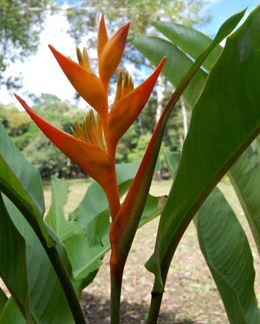Heliconias are these beautiful flowering plants that every gardener wants to nurture. If you too, want to live in their delighting presence, then this Buzzle article will tell you all about how to take care of them, so that they bloom, thrive, and adorn your garden space.

Heliconias are known for their bright and vibrant colors, and are every gardener's favorite choice when it comes to landscaping! They are also known as
lobster-claw―because they look like them,
false bird-of-paradise―because they resemble the flowers known as the bird of paradise, and
wild plantain. These plants are native to the tropical regions of America and the Pacific Ocean islands towards the west of Indonesia. The term 'heliconia' is derived from a Greek word
helikonios after Mount Helicon, which according to Greek mythology is the seat of the Muses―the 9 goddesses of science and arts.
There are about 100 to 200 species of the heliconia plant, and each species varies in size and color. Did you know that it is the bright-colored bracts of these plants that contain the true flowers? As you can see in the image on your right, the bright red bracts contain small yellow flowers. Because these bracts protect the flowers, pollination is mostly done by creatures like hummingbirds and bats.
Scientific Classification
Scientific Facts
Family: Heliconiaceae
Genus:
Heliconia
Kingdom: Plantae
Order: Zingiberales
Division: Magnoliophyta
The Heliconia genus was earlier a part of the Musaceae family but now, is in the family of Heliconiaceae. There are about 100 to 200 species, which can grow from 3 to 30 feet tall. The "flowers" are actually modified leaves and bracts which contain the true flowers inside them, so that only specialized birds, such as the hummingbird, can take their nectar. The leaves come in attractive colors―orange, green, red, pink―which grow opposite to each other. In fact, as the plant ages, the leaves form large clumps, thereby arising the need to cut the extra ones.
Caring Measures
Heliconias are non-woody plants, and the flowers are grown on long, erect, or mostly drooping branched clusters. Being tropical, it is important to focus on their water and sunlight needs. Mentioned below are some important tips that you need to know, in order to grow them beautifully in your garden.
- You must make sure that the soil is well drained and rich in organic matter. Loamy soil rich in humus would work best.
- The spacing is very important for proper growth of the heliconias. As mentioned earlier, there are many different species, so you must know whether they are the ones that form a cluster at one spot, or need space to spread themselves. It is advisable to grow them with a space of 4 to 6 feet.
- You must water them very frequently (depending upon the species). Heliconias love water, and therefore, it is advisable to water them once in the morning and evening. Make sure that you don't overwater, as they might get fungus. Just never let the soil go dry.
- It would be good if you can keep them under direct sunlight for 6 hours every day. You can also use a sun lamp, if need be.
- Another important point to keep in mind, is to feed them with fertilizers at least once in the season, bone meal being the most preferred one.
- Once they have bloomed, it is important to cut the stalk, all the way to the ground. This helps in promoting flower growth.
- Mulching regularly helps in weed control and retains necessary moisture that is required around the roots.
- Always remember to clean off the dead leaves and stems from the plant as soon as possible. You can also chop the extra leaves, as they cluster when the plant begins to age.
Taking care of this plant is not a piece of cake, but if you take care of the basic needs, then heliconias are not demanding at all! The best part about the attention and hard work on the plant, is that your efforts will be rewarded when you see these flowers blooming in your garden, and gathering the attention of all those around. Good luck.






 Heliconias are known for their bright and vibrant colors, and are every gardener's favorite choice when it comes to landscaping! They are also known as lobster-claw―because they look like them, false bird-of-paradise―because they resemble the flowers known as the bird of paradise, and wild plantain. These plants are native to the tropical regions of America and the Pacific Ocean islands towards the west of Indonesia. The term 'heliconia' is derived from a Greek word helikonios after Mount Helicon, which according to Greek mythology is the seat of the Muses―the 9 goddesses of science and arts.
Heliconias are known for their bright and vibrant colors, and are every gardener's favorite choice when it comes to landscaping! They are also known as lobster-claw―because they look like them, false bird-of-paradise―because they resemble the flowers known as the bird of paradise, and wild plantain. These plants are native to the tropical regions of America and the Pacific Ocean islands towards the west of Indonesia. The term 'heliconia' is derived from a Greek word helikonios after Mount Helicon, which according to Greek mythology is the seat of the Muses―the 9 goddesses of science and arts.